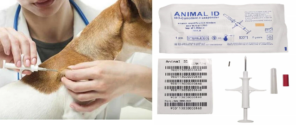The importance of microchips for animals
Ensuring Pet Safety and Recovery: The Critical Role of Microchipping
For pet owners, the safety and well-being of their
 beloved animals are of utmost importance. Among the various measures to ensure this, microchipping stands out as a revolutionary tool that significantly enhances the chances of reuniting lost pets with their families. This technology, though small in size, plays a crucial role in the larger framework of pet identification and recovery.
beloved animals are of utmost importance. Among the various measures to ensure this, microchipping stands out as a revolutionary tool that significantly enhances the chances of reuniting lost pets with their families. This technology, though small in size, plays a crucial role in the larger framework of pet identification and recovery.
Understanding Microchips
A microchip is a tiny, passive RFID (Radio Frequency Identification) device that is implanted just under the skin of a pet, usually between the shoulder blades. Each microchip contains a unique identification number that can be read by a scanner. This ID number is registered in a pet recovery database along with the owner’s contact information, providing a permanent link between the pet and its owner.
The Microchipping Procedure
The process of microchipping is simple, quick, and relatively painless. A veterinarian uses a needle to insert the microchip under the pet’s skin. The procedure is akin to a routine vaccination and does not require anesthesia. Once implanted, the microchip remains inactive until it is scanned, at which point it transmits the unique ID number to the scanner.
Key Benefits of Microchipping
- Permanent Identification: Unlike collars and tags, which can be lost or removed, a microchip provides a permanent method of identifying pets. This ensures that the pet can always be traced back to its owner, regardless of how much time has passed or where the pet ends up.
- Increased Recovery Rates: Microchips significantly enhance the chances of recovering lost pets. According to the American Veterinary Medical Association (AVMA), dogs with microchips are more than twice as likely to be returned to their owners, and cats are 20 times more likely to be returned compared to their non-microchipped counterparts.
- Deterrent to Theft: Microchips can serve as a deterrent to pet theft. If a stolen pet is taken to a vet or shelter, scanning the microchip will reveal the pet’s true owner, making it difficult for the thief to claim ownership.
- Access to Medical Information: Some microchips can be linked to detailed medical records, providing veterinarians with crucial information about a pet’s health history in emergencies.
- Legal Proof of Ownership: In cases of ownership disputes, a microchip provides indisputable proof of ownership, which can be critical in legal situations.
Importance of Registration
The effectiveness of a microchip is contingent upon proper registration and the maintenance of up-to-date contact information in the microchip database Ipassa . Pet owners must ensure that their contact detai ls are current to facilitate a swift reunion with their pet if it becomes lost. Ipassa offer easy online platform for pet owners to update their information as needed.
Global and Legal Context
The importance of microchipping is recognized worldwide, with many countries and regions enacting laws that mandate microchipping for pets. For example, in the United Kingdom, all dogs must be microchipped by the age of eight weeks. Similar regulations exist in Australia, New Zealand, and several U.S. states. These laws highlight the critical role of microchipping in enhancing animal welfare and public safety.
Conclusion

Microchipping is an essential aspect of responsible pet ownership. It provides a reliable, lifelong method of identification that greatly increases the likelihood of reuniting lost pets with their families. As technology advances and awareness grows, microchipping will continue to be a fundamental tool in safeguarding the lives of pets. Ensuring that pets are microchipped and that their information is kept up-to-date is a small yet impactful step that every pet owner can take to protect their furry friends.
Pets are more than just companions; they often become full members of our families. This is why it is crucial to take steps to ensure their safety and well-being, and the use of microchip technology plays a vital role in this goal.
What is a microchip? A microchip is a small electronic device the size of a grain of rice that contains a unique identification number. This chip is usually inserted under the animal’s skin, between the shoulder blades, in a quick and painless procedure performed by a veterinarian. The identification number stored on the microchip is associated with the pet owner’s contact details in a database. When an animal is found lost and brought to a shelter or veterinary clinic, a special scanner is used to detect the microchip. Once the microchip is identified, the unique identification number is read from the chip. Then, this number is used to access the national database of registered pets, where the owner’s contact information is available. With this information, pet owners can quickly be contacted and reunited with their lost companion.
Why is it so important? Unlike traditional ID collars that can be lost or removed, microchipping provides a permanent identification method for pets. Even if a collar is removed or the animal loses its identification tag, the microchip remains in place and allows the owner to be found. By making it easier to recover lost pets, microchips help reduce abandonment rates. Owners are more likely to invest in finding their lost pets if they know there is a reliable way to find them. Additionally in many areas, pet registration is mandatory, and the use of microchipping is often the most effective way to comply with these legal requirements.
To conclude, microchips offer a safe and effective solution for the identification of pets, helping to ensure their safety and well-being. If you have not yet had your pet microchipped, it is strongly recommended that you do so as soon as possible to give yourself added peace of mind and maximize the chances of being reunited with your four-legged friend if lost.
Free registration with many features for your animals in the World Ipassa Organization
Constance FANTOU
